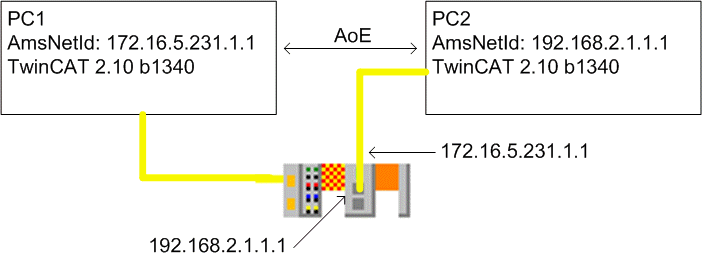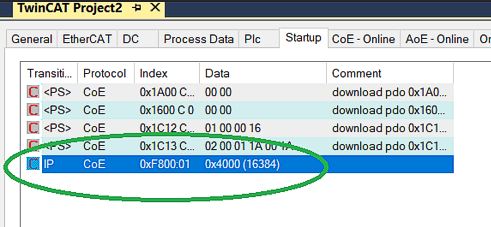Handling acyclic data
In addition to cyclic PDO, the EL6692 can also transport so-called acyclic data (mailbox traffic) to the respective opposite side. These data streams can be of different types, different protocols are defined, which are transported in this way.
Note: the EL6692 as predecessor of the EL6695 offers here only limited functions (see following explanations), with extensive requirements concerning the protocol transport please check the EL6695 for usability.
EoE (Ethernet-over-EtherCAT)
Explanation of the EoE function in the EL6692: When the operating system (Windows) is instructed to send an IP frame (e.g. to 192.168.2.1), it uses a broadcast to all available network adapters to determine through which adapter the destination address can be reached. The EL6692 transports this broadcast, which reaches it through acyclic mailbox communication it to the other side, which responds based on its network mask.
AoE (ADS-over-EtherCAT)
ADS (Automation Device Specification) is a Beckhoff-specific protocol for data exchange between hardware- or software-based devices. The configuration of these ADS telegrams is described in the Beckhoff Information System. AoE is a VoE (vendor-specific protocol over EtherCAT). The EL6692 can transport ADS telegrams to the other side directly (AoE), i.e. without underlying IP channel.
To this end the EL6692 must be entered in the System Manager as an ADS gateway; see the following  sample (Download)
sample (Download)
Two PCs with TwinCAT 2.10, b1340 and an EL6692 with Firmware 05 are used.

Both PCs send 10,000 bytes of data each to the other side. An Ads-Write is used on the sender side and the Indication/Response method on the receiver side. To this end, the target AmsNetId must be entered in both System Manager configurations so that, for sample, the ADS router in PC1 can reach the ADS device ‘192.168.2.1.1.1’ via the ‘channel’ EL6692.
The procedure is as follows on the primary side; the secondary side (PC2) follows suit.

If an EL6692 (A) exists, the NetId of the EL6692 (D) can be changed (E) under RouteSettings (B), NetIdManagement (C).

After activating the configuration and restarting TwinCAT, the ADS router is now instructed to send queries to the ADS device 192.168.2.1.1.1 via the AoE interface of the EL6692. AoE must be activated in the advanced settings of the EL6692.

Forwarding blocking for acyclic data (mailbox traffic)
As of firmware 12, the forwarding of some protocols can be specifically blocked. To do this, the following bits must be set in the CoE index 0xF800:01:
AoE: 0x8000
EoE: 0x4000
FoE: 0x2000
VoE: 0x0800
Blocking protocols can be helpful if EtherCAT devices communicate frequently, e.g. during the start-up phase of the system, and this is transmitted by the bridge terminal to the opposite EtherCAT system and causes unwanted reactions there. E.g. the lock can be entered as StartUp command in the transition INIT->PreOP:
